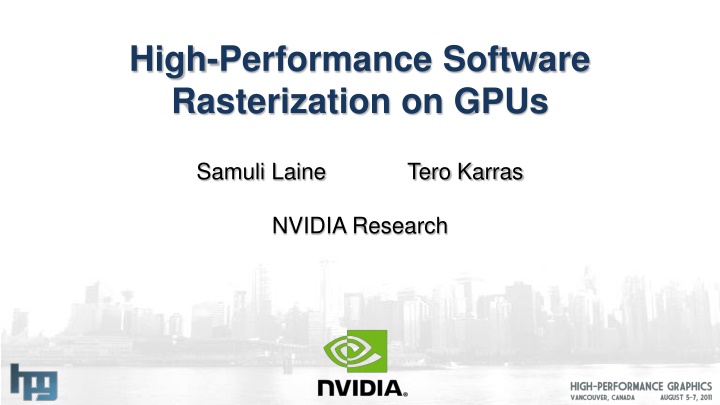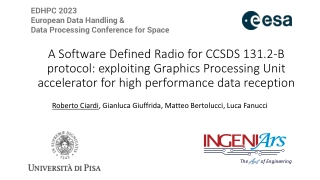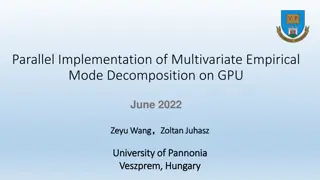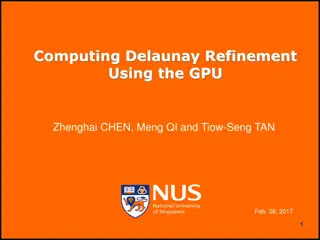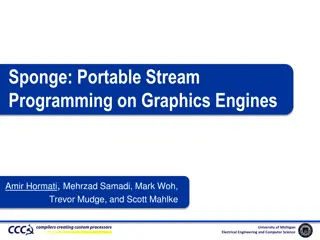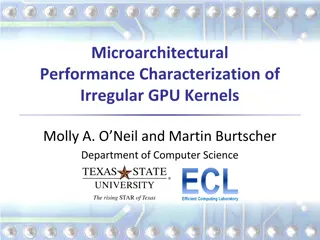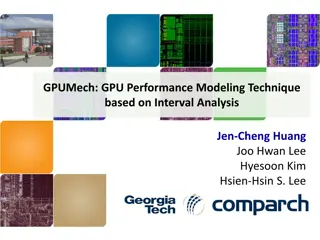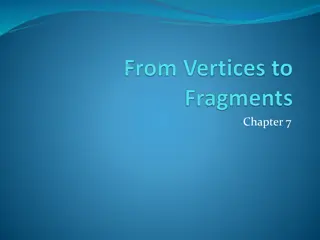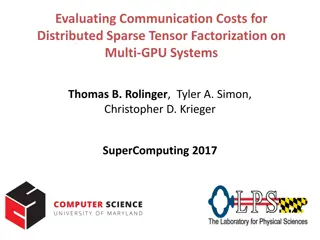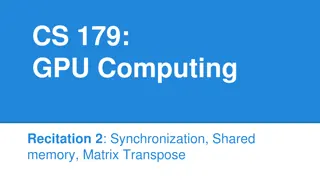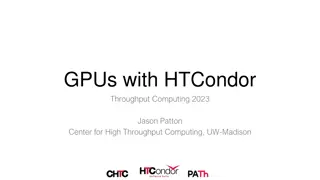Cutting-Edge GPU Software Rasterization
Dive into high-performance software rasterization techniques on GPUs, exploring programmable graphics pipelines, project goals, previous work comparisons, design considerations, and pipeline structures. Discover advanced concepts and future hardware ideas in this innovative field.
Download Presentation

Please find below an Image/Link to download the presentation.
The content on the website is provided AS IS for your information and personal use only. It may not be sold, licensed, or shared on other websites without obtaining consent from the author.If you encounter any issues during the download, it is possible that the publisher has removed the file from their server.
You are allowed to download the files provided on this website for personal or commercial use, subject to the condition that they are used lawfully. All files are the property of their respective owners.
The content on the website is provided AS IS for your information and personal use only. It may not be sold, licensed, or shared on other websites without obtaining consent from the author.
E N D
Presentation Transcript
High-Performance Software Rasterization on GPUs Samuli Laine Tero Karras NVIDIA Research
Graphics and Programmability Graphics pipeline (OpenGL/D3D) Driven by dedicated hardware Executes user code in shaders What s next in programmability?
Programmable Graphics Pipeline But what does it mean? Another API? More programmable stages? Coupling between CUDA/OpenCL and OpenGL/D3D? Or it s just a program ?
Our Approach Try and implement a full pixel pipeline using CUDA From triangle setup to ROP Obey fundamental requirements of gfx pipe Maintain input order Hole-free rasterizer with correct rasterization rules Prefer speed over features
Project Goals Establish a firm data point through careful experiment Provide fully programmable platform for exploring algorithms that extend the hardware gfx pipe Programmable ROP Stochastic rasterization Non-linear rasterization Non-quad derivatives Quad merging Decoupled sampling Compact after discard etc. Ideas for future hardware Ultimate goal = flexibility of software, performance of fixed-function hardware
Previous Work: FreePipe [Liu et al. 2010] Very simple rasterization pipeline Each triangle processed by one thread Blit pixels directly to DRAM using atomics Limitations Cannot retain inputs order Limited support for ROP operations (dictated by atomics) Large triangles game over We are 15x faster on average Larger difference for high resolutions
Design Considerations Run everything in parallel We need a lot of threads to fill the machine Minimize amount of synchronization Avoid excessive use of atomics Focus on load balancing Graphics workloads are wild
Pipeline Structure Chunker-style pipeline with four stages Triangle setup Bin raster Coarse raster Fine raster Run data in large batches Separate kernel launch for each stage Keep data in input order all the time
Chunking to Bins and Tiles Frame buffer Bin 16x16 tiles 128x128 px Tile 8x8 px Pixel
Pipeline Stages Quick look at each stage More details in the paper
Triangle Setup Vertex buffer positions, attributes Index buffer . . . edge eqs. u/v pleqs zmin etc. Triangle Setup Triangle data buffer . . .
Triangle Setup Fetch vertex indices and positions Clip if necessary (has guardband) Frustum, backface and between-samples cull Setup screen-space pleqs for u/w, v/w, z/w, 1/w Compute zmin for early depth cull in fine raster One-to-one mapping between input and output Trivial to employ full chip while preserving ordering
Bin Raster Triangle data buffer . . . Bin Raster SM 0 Bin Raster SM 1 Bin Raster SM 14 . . . IDs of triangles that overlap bin
Bin Raster, First Phase Pick triangle batch (atomic, 16k tris) Read 512 set-up triangles Compact/expand according to culling/clipping results Efficient within thread block Repeat until has enough triangles to utilize all threads
Bin Raster, Second Phase Rasterize Determine bin coverage for each triangle (1 thread per tri) Fast paths for 2x2 and smaller footprints Output Output to per-SM queue no sync between SMs
Coarse Raster . . . One coarse raster SM has exclusive access to the bin it s processing Coarse Raster SM n IDs of triangles that overlap tile
Coarse Raster Input Phase Merge from 15 input queues (one per bin SM) Continue until enough triangles to utilize all threads Rasterize Determine tile coverage for each triangle (1 thread per tri) Fast paths for small / largely overlapping triangles Output Highly varying number of output items divide evenly to threads Only one SM outputs to tiles of any given bin no sync needed
Fine Raster IDs of triangles that overlap tile One fine raster warp has exclusive access to the tile it s processing Fine Raster warp n Read tile once from DRAM to shared Write tile once to DRAM Pixel data in FB
Fine Raster Pick tile, read FB tile, process, write FB tile Input Read 32 triangles in shared memory Early z kill based on triangle zmin and tile zmax Calculate pixel coverage using LUTs (153 instr. for 8x8 stamp) Repeat until has at least 32 fragments Raster Process one fragment per thread, full utilization Shade and ROP
Tidbit 1: Coverage Calculation Step along edge (Bresenham-like) Use look-up tables to generate coverage masks ~50 instructions for 8x8 stamp, one edge
Tidbit 2: Fragment Distribution Input Phase Shading Phase In input phase, calculate coverage and store in list In shading phase, detect triangle changes and calculate triangle index and fragment in triangle
Test Scenes Call of Juarez scene courtesy of Techland S.T.A.L.K.E.R.: Call of Pripyat scene courtesy of GSC Game World
Results: Performance Frame rendering time in ms (depth test + color, no MSAA, no blending)
Results: Memory Usage San Miguel Juarez Stalker City Buddha Scene data 189 24 11 51 29 Triangle setup data 420.0 42.2 26.9 67.9 84.0 Bin queues 4.0 1.5 1.2 0.9 2.0 Tile queues 4.4 2.9 2.2 2.2 1.5 Memory usage in MB
Comparison to Hardware (1/3) Resolution Cannot match hardware in raster, z kill + compact Currently support max 2K x 2K frame buffer, 4 subpixel bits Attributes Fetched when used bad latency hiding Expensive interpolation Antialiasing Hardware nearly oblivious to MSAA, we much less so
Comparison to Hardware (2/3) Memory usage, buffering through DRAM Performance implications of reduced buffering unknown Streaming through on-chip memory would be much better + Shader complexity Shader performance theoretically the same as in graphics pipe + Frame buffer bandwidth Each pixel touched only once in DRAM
Comparison to Hardware (3/3) + Extensibility Need one stage to do something extra? Need a new stage altogether? You can actually implement it + Specialization to individual applications Rip out what you don t need, hard-code what you can
Exploration Potential Shader performance boosters Compact after discard, quad merging, decoupled sampling, Things to do with programmable ROP A-buffering, order-independent transparency, Stochastic rasterization Non-linear rasterization (Your idea here)
The Code is Out There The entire codebase is open-sourced and released http://code.google.com/p/cudaraster/
Thank You Questions
